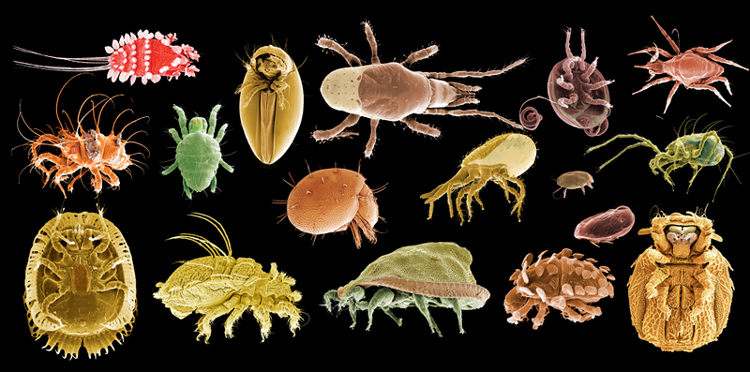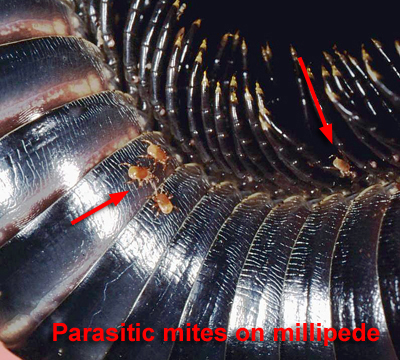Is it a mite? Version 1.0
DRAFT VERSION - PLEASE SEND COMMENTS & CORRECTIONS TO:
DAVE WALTER: [email protected]

Although experienced APHIS inspectors are unlikely to ask this question often, identification of the Subclass Acari or Acarina (Class Arachnida) is not always easy. Mites are so small, morphologically diverse, and often bizarrely modified, that even specialists occasionally made an incorrect first diagnosis. There is even a case in the literature of a mite having been misdescribed as a new species of spider. This key is provided in the hopes that if a suspicious looking tiny arthropod is encountered in an inspection, it can quickly be determined if it is a mite. A second, objective of this key is to begin introducing and explaining the terminology that will be used in other keys under development. Terms are explained in the character state notes and images and in a separate Glossary. Ideally, when new inspection officers are trained, this key and its successors will be their introduction to the world of mites.
-
This key separates mites (Subclass Acari) from other arachnids and small invertebrates.
Based on personal experience, confusion is most likely with those tiny hexapods and arachnids that overlap mites in size (mostly those with body lengths of less than a few millimeters), especially when obvious characters such as wings, antennae, and primary segmentation are obscure or absent. Even usually large arachnids like scorpions and whipscorpions, however, may have small stages that could be confused with mites and often harbor mites.
 Although
the primary purpose of this key is to separate mites from other arthropods, it
will also identify most other arachnids to order and distinguish several groups of
mandibulate 'microarthropods'.
Although few of these groups
have species of high quarantine importance, many are common and likely to be
intercepted, especially if the shipment contains soil, vegetation or forest
products. Some of these groups are rare and contain species of potential
conservation concern, and some (e.g. scorpions, spiders, centipedes,
millipedes, insects) have large species popular in the pet trade. It is
important to note that many of these larger arthropods have their own mite
fauna that may be of quarantine concern.
Although
the primary purpose of this key is to separate mites from other arthropods, it
will also identify most other arachnids to order and distinguish several groups of
mandibulate 'microarthropods'.
Although few of these groups
have species of high quarantine importance, many are common and likely to be
intercepted, especially if the shipment contains soil, vegetation or forest
products. Some of these groups are rare and contain species of potential
conservation concern, and some (e.g. scorpions, spiders, centipedes,
millipedes, insects) have large species popular in the pet trade. It is
important to note that many of these larger arthropods have their own mite
fauna that may be of quarantine concern.
-
This key runs on the LucID Player Version 2.1 and is a multi-access interactive key.
A user can start using a multi-access key with any character in the key that is visible on their specimen and proceed to any other character of choice: there is no single correct path to an identification. In addition, important character states are repeated under several of the individual characters, so the chance of missing an important character is decreased.
When in doubt about a character, skip it and use another.
An important purpose of this key is to begin introducing morphological terms that will be used in later keys. This in-built interactive glossary should be useful in training new inspection officers. Each character state (up to 15 per character) is supported by an illustration (a line drawing whenever possible) and a fact sheet that often contains additional images (including scanning electron and light micrographs).
Use
the character state fact sheets. Most of
these contain additional images as well as a description of
the character state and its distribution among taxa. The fact sheets
also state
when Allow Misinterpretations has been used. This
is the default option in Lucid, but can be turned off at the start of a
session by using the key pull down menu. Additional notes and images
can be found under each taxon and in the general information section.
Images: Most of the images used in these keys have been commissioned or created by
the author who retains the rights to them. A few of the line drawings of
insects have been modified from the 'Agriculture Handbook No. 655, Insect
and Mite Pests in Food An Illustrated Key Volume 1 and Volume 2'. The line drawing of a cladoceran is modified from
Livingstone at BIODIDAC
(http://biodidac.bio.uottawa.ca/). Matthew
Boeckner (tardigrades) and Dr HC Proctor (mites, spiders, insects) (http://www.biology.ualberta.ca/faculty/heather_proctor)
contributed some of the photographs.
Dr David Evans Walter
Colorado State University & the University of Alberta
([email protected] or [email protected])
DRAFT VERSION - PLEASE SEND COMMENTS & CORRECTIONS TO:
DAVE WALTER: [email protected]